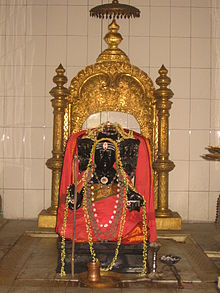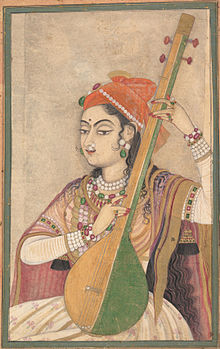Thyagaraja Aradhana
| Tyagaraja Aradhana | |
|---|---|
 |
|
| Dates | January / February |
| Location(s) | Thiruvaiyaru, Tamil Nadu, India |
| Years active | 1846�–present |
| Music of India | |
|---|---|

A Lady Playing the Tanpura, ca. 1735 (Rajasthan)
|
|
| Genres | |
|
|
| Media and performance | |
| Music awards | |
| Music festivals |
|
| Music media | |
| Nationalistic and patriotic songs | |
| National anthem | Jana Gana Mana |
| Regional music | |
|
|
Tyagaraja Aradhana is the annual aradhana of saint composer Tyagaraja. Carnatic musicians from all over the world descend and pay homage to the saint. The aradhana is observed on Pushya Bahula Panchami day when the saint attained samadhi. The venue of the festival is near the samadhi of Tyagaraja on the banks of River Cauvery. On Pushya Bahula Panchami day, musicians will sit on either side of the samadhi and render the saint's Pancharatna kritis in chorus as a mark of homage. Many exponents of Carnatic music come to perform and are watched by thousands of ardent fans of Indian classical music.
The aradhana (Ceremony of Adoration) is held every year on the anniversary of the demise of the saint. This is on Pushya Bahula Panchami day (the fifth day of the waning moon in the Hindu lunar month of Pushya). The Aradhana is conducted by the Sri Thyagabrahma Mahotsava Sabha and is held in the precincts of the samadhi (memorial) of the saint located at Thiruvaiyaru village, Thanjavur district, Tamil Nadu, India.
The Aradhana in its present format is not even a hundred years old. Tyagaraja died in 1847. A few days before his death, he had formally renounced everything and become a sanyasi. When he passed on, his mortal remains were buried on the banks of the river Kaveri and a small memorial was built at the site. His disciples returned to their respective villages and observed his death anniversary at their own homes. The memorial soon fell into neglect and had become quite dilapidated by 1903, when two of the last surviving students to have been taught by Tyagaraja happened to make a nostalgic visit to the site. These were the elderly and eminent musicians Umayalpuram Krishna Bhagavatar and Sundara Bhagavatar. They were dismayed by the neglect and dilapidation; indeed, they had to search for the memorial in the wild foliage of the riverbank. They arranged for the renovation of the samadhi and decided to commemorate the tithi or death anniversary of their guru every year at the Samadhi itself.
From the following year, efforts were made by musical stalwarts to observe the death anniversary regularly at Tiruvayyaru, and to use the occasion as an opportunity for his followers to converge and interact with each other. In 1905, a lavish ceremony, complete with feeding of the poor and worship at the memorial as per Vedic tenets, was celebrated. While Umayalpuram Krishna Bhagavatar and Sundara Bhagavatar were the moving force behind the renovations and celebrations, the brothers Tillaisthanam Narasimha Bhagavatar and Tillaisthanam Panju Bhagavatar were the main financiers and organizers. By the following year, the brothers had fallen out with each other. From 1906 onwards, each began conducting a parallel Aradhana. Various musicians also began aligned themselves with one or the other brother and two rival factions came into being. The group (and the aradhana celebration) conducted by Narasimha Bhagavatar came to be called the Periya Katchi ("senior party," since he was the elder) and that of Panju Bhat became known as the Chinna Katchi. With the passing of the Tillaisthanam brothers, the Periya Katchi came under the control of the ace violinist Malaikottai Govindasami Pillai, and the Chinna Katchi under that of Soolamangalam Vaidyanatha Bhagavatar, the noted Harikatha exponent. Gradually, a convention emerged whereby the Chinna Katchi's celebrations began five days before the Aradhana and concluded on the Aradhana day, while the Periya Katchi's celebration began on Aradhana day and continued for four days after that. Both groups organised music performances and feeding of the poor and so the public was the real beneficiary during the nine days. On one point, both groups were united. They did not allow "performing women," a euphemism for women of ill repute, to perform during the Aradhana. In those days, no decent woman ever sang or danced in public and the profession of entertainment was strictly the domain of the courtesan, who was often a devadasi or temple performer. Another point in common between the two groups was that they did not permit nadaswaram performances.
...
Wikipedia
